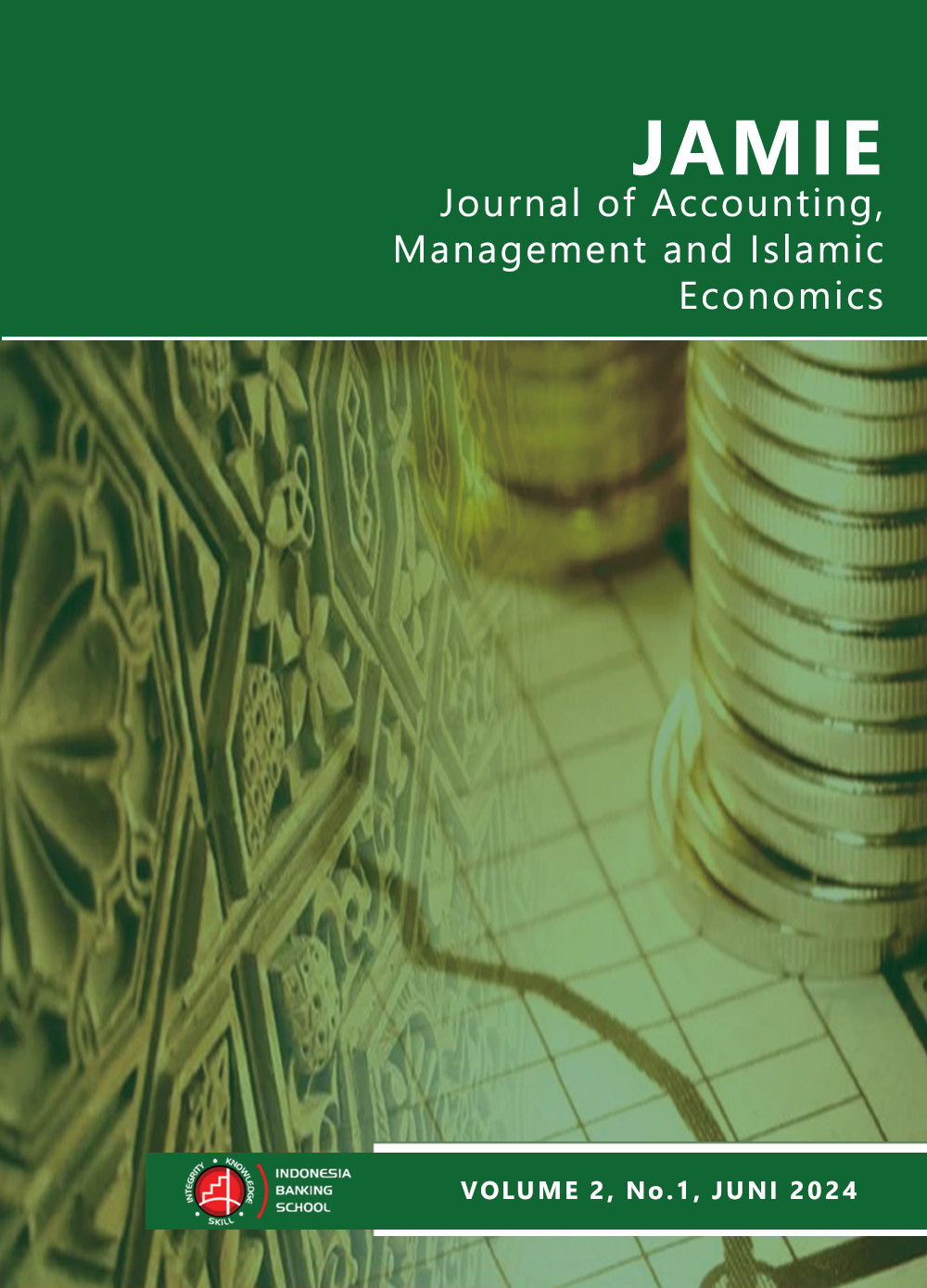ANALISIS PERBANDINGAN CAMEL PADA BANK BCA SYARIAH SEBELUM DAN SELAMA PANDEMI COVID-19
DOI:
https://doi.org/10.35384/jamie.v2i1.540Keywords:
CAMEL, Financial Performance, CAR, NPF, BOPO, FDR, ROAAbstract
The Covid-19 pandemic has had an impact on various aspects of the economy and business activities. The Covid-19 pandemic has an impact on banking and financial performance which will af ect the level of bank health. There is a way that can be done to determine the impact of the pandemic regarding bank health, namely by requiring objective and precise benchmarks. This research aims to analyze financial reports on the performance of Sharia Banks before the Covid-19 pandemic and during the Covid-19 pandemic. The data analysis method applied in this research is quantitative descriptive analysis. Quantitative analysis is a scientific method because it meets scientific principles, namely empirical concreteness, objective, measurable, rational and systematic. This analysis uses research data in the form of numbers and carries out statistical analysis (Sugiyono, 2013). Then, the analysis tool in this research uses the time series data analysis model. The sampling method in this research is Non-Probability Sampling. The sampling technique for this research is saturated sampling. 12 samples were applied before the Covid-19 pandemic and 12 samples were applied during the Covid-19 pandemic. The testing tool used is SPSS version 24. The research results show that the CAMEL method shows that in the Capital Adequacy Ratio, Non Performing Financing, BOPO ratios there is a significant dif erence between before the Covid-19 pandemic and during the Covid-19 pandemic, while the Return on Assets indicator shows that there is no significant dif erence between before and during the Covid-19 pandemic. Financing to Deposit Ratio shows that there is no significant dif erence between before and during the Covid-19 pandemic.
References
Aji Permana, Bayu. 2012. Analisis Tingkat Kesehatan Bank Berdasarkan Metode CAMELS dan Metode RGEC. Universitas Negeri Surabaya
Aliyah, L. H., & Putra, P. (2022). ANALISIS FORECASTING DALAM PERKEMBANGAN KINERJA KEUANGAN PADA BPRS HARTA INSAN KARIMAH CIBITUNG PERIODE 2013-2020. MASLAHAH (Jurnal Hukum Islam Dan Perbankan Syariah), 13(1), 105–126. https://doi.org/10.33558/maslahah.v13i1.4456
Andrean, D., & Mukhlis, I. (2021). Analisis pengaruh kredit perbankan, pembiayaan bank syariah dan investasi terhadap pertumbuhan ekonomi di Indonesia periode sebelum pandemi Covid-19 (2015-2019) dan periode pandemi Covid-19 tahun 2020. Jurnal Ekonomi, Bisnis Dan Pendidikan, 1(9), 844–853. https://doi.org/10.17977/um066v1i92021p844-853
Badrul Munir, M. binti, & Ahmad Bustamam, U. S. (2017). Camel Ratio on Profitability Banking Performance (Malaysia Versus Indonesia). International Journal of Management, Innovation & Entrepreneurial Research, 3(1), 30–39. https://doi.org/10.18510/ijmier.2017.314
Bahakhiri, H., & Leniwati, D. (2022). Analisis Perbandingan Kinerja Keuangan Antara Bank Islam Thailand Dengan Bank Umum Periode 2017-2019. Muhammadiyah Riau Accounting and Business Journal, 3(1), 040–049. https://doi.org/10.37859/mrabj.v3i1.2786
Barlian, I. (2018). Peranan analisis laporan keuangan untuk menilai kinerja keuangan PT. Sumber Alfaria Trijaya, Tbk. periode 2014-2016. repository.unpar.ac.id. https://repository.unpar.ac.id/handle/123456789/5896
Dincer, H., Gencer, G., Orhan, N., & Sahinbas, K. (2011). A performance evaluation of the Turkish banking sector after the global crisis via CAMELS ratios. Procedia - Social and Behavioral Sciences, 24, 1530–1545. https://doi.org/10.1016/j.sbspro.2011.09.051
Fahmi, C. K. I., & Si, M. (2017). Analisis Laporan Keuangan. In Alfabeta, Bandung.
Hidayat, W. W. (2022). CAMEL Ratio on Profitability Banking performance: Case Studies of Banks in Indonesia. Atestasi : Jurnal Ilmiah Akuntansi, 5(2), 456–468. https://doi.org/10.57178/atestasi.v5i2.10
Kasmir, S. E. (2018). Bank dan lembaga keuangan lainnya edisi revisi. Rajawali Pers.
Keffala, M. R. (2021). “How using derivative instruments and purposes affects performance of Islamic banks? Evidence from CAMELS approach.” Global Finance Journal, 50(August 2019), 100520. https://doi.org/10.1016/j.gfj.2020.100520
Muhammad, R., & Nawawi, M. (2022). Kinerja Keuangan Bank Syariah di Indonesia Sebelum dan Selama Pandemi Covid-19. El-Mal: Jurnal Kajian Ekonomi & Bisnis Islam, 3(5), 854–867. https://doi.org/10.47467/elmal.v3i5.1133
Osmotik, A. P., & Sibarani, B. B. (2022). ANALISIS PERBANDINGAN KINERJA KEUANGAN PERBANKAN SEBELUM DAN SELAMA PANDEMI COVID-19 (Studi kasus PT. BANK RAKYAT INDONESIA Tbk. Periode 2018 S/D 2021). Jurnal Bisnis & Akuntansi Unsurya, 7(2). https://doi.org/10.35968/jbau.v7i2.902
Pracoyo, A., & Imani, A. (2017). PENGARUH PERMODALAN, RISIKO KREDIT, DAN RISIKO LIKUIDITAS TERHADAP PROFITABILITAS PADA BANK DENGAN KATEGORI BUKU (BANK UMUM KEGIATAN USAHA). Media Ekonomi, 25(1), 15–24. https://doi.org/10.25105/me.v25i1.5200
Riyadi, S. (2003). Banking assets and liability management. Lembaga Penerbit Fakultas Ekonomi Universitas Indonesia.
Roman, A., & Şargu, A. C. (2013). Analysing the Financial Soundness of the Commercial Banks in Romania: An Approach based on the Camels Framework. Procedia Economics and Finance, 6(13), 703–712. https://doi.org/10.1016/s2212-5671(13)00192-5
Saputra, Y. F., Supeni, R. E., & Hafidzi, A. H. (2021). STUDI KOMPARASI KINERJA KEUANGAN PT. BANK RAKYAT INDONESIA DAN PT. BANK NEGARA INDONESIA PADA SAAT PANDEMI COVID -19. Jurnal Muhammadiyah Manajemen Bisnis, 2(2), 63. https://doi.org/10.24853/jmmb.2.2.63-72
Sullivan, V. S., & Widoatmodjo, S. (2021). Kinerja Keuangan Bank Sebelum Dan Selama Pandemi (COVID – 19). Jurnal Manajerial Dan Kewirausahaan, 3(1), 257. https://doi.org/10.24912/jmk.v3i1.11319
Sutrisno, S., Panuntun, B., & Adristi, F. I. (2020). The Effect of Covid-19 Pandemic on the Performance of Islamic Bank in Indonesia. EQUITY, 23(2), 125–136. https://doi.org/10.34209/equ.v23i2.2245
Umardani, D., & Muchlish, A. (2017). ANALISIS PERBANDINGAN KINERJA KEUANGAN BANK SYARIAH DAN BANK KONVENSIONAL DI INDONESIA. Jurnal Manajemen Dan Pemasaran Jasa, 9(1), 129–156. https://doi.org/10.25105/jmpj.v9i1.1438
Downloads
Published
Issue
Section
License
Copyright (c) 2024 Journal of Accounting, Management and Islamic Economics

This work is licensed under a Creative Commons Attribution 4.0 International License.

